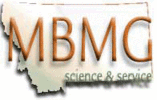
The Montana Bureau of Mines and Geology is the principal source of
earth science information for the citizens of Montana. Since 1919, it
has been mandated to conduct research and assist in the orderly
development of the State's mineral and water resources. As a
non-regulatory agency, the Bureau provides extensive advisory,
technical, and informational services on geologic, mineral, energy,
and water resources in the State. Increasingly, the Bureau also is
involved in the study of environmental impacts to land and water,
whether the impacts were caused by past practices in hard-rock mining
or by current activities in agriculture or industry.
The Bureau's basic support comes from a biennial legislative
appropriation. Additionally, the Bureau seeks funding for extensive
research from outside sources. Many of our projects are conducted
jointly with various State and Federal agencies, county governments,
municipalities, and other local groups. Operating out of two offices
in Montana, in Butte and Billings (located on the Montana Tech and
MSU-Billings campuses, respectively), we employ 59 full-time staff,
including 31 research professionals and 24 in technical/clerical
positions. Products of the Bureau's research are published by our
Information Services Division or through the scientific literature.
http://www.mbmg.mtech.edu/
pubsales@mtech.edu
Location
1300 West Park Street
Butte
, MT
59701-8997
|

The Montana Bureau of Mines and Geology (MBMG) Mining Property File collection was amassed over the years through private and industry donations of engineering and geologic reports, pictures, correspondence, news clippings, and production information. The collection presently contains over 4,400 property-specific files (records). The physical files are organized first by Montana county and then by mine or project name. Files may contain information related to a particular mining claim, a collection of claims, or a mining exploration project. Metadata describing each record includes property name, location (county, historical mining district, township, range and section), georeferences (latitude and longitude), and...
|

Beginning August 1989, a triggered digital recording system was implemented that captured data for larger events but did not provide continuous digital recording. From August 1999 through July 2000, paper seismograms were the only source of continuous seismic data for Montana¿s Regional Seismic Network. This network includes data from 35 recording stations operated by the MBMG as well as data from 7 USGS stations located in Montana and operated cooperatively with the MBMG. Continuous digital data recorded since August 15, 2001 is archived at the Incorporated Research Institutions for Seismology (IRIS) Data Management Center using a SEED data format. Daily electronic seismograms may be accessed by the general public...
|

Geoscientific collections managed by Montana Geological Survey are aggregated in the National Digital Catalog to enhance discovery and use of valuable samples and data for further scientific research. Contact information and material access instructions are provided for the individual collections.
|

The Earthquake Studies Office (ESO) of the Montana Bureau of Mines and Geology opened in June, 1980 to operate the Montana Regional Seismograph Network. The office collects and analyzes seismic data and reports earthquake information. The ESO also collects and stores seismograms recorded in Montana by other groups and agencies. Prior to 1989, the only method used to collect earthquake data was paper seismograms recorded on drum recorders using pen and ink, or heat pen and heat-sensitive paper. Thus, paper seismograms recorded before 1989 are original (and irreplaceable) records. Beginning August 1989, a triggered digital recording system was implemented that captured data for larger events but did not provide continuous...
|

The Mineral Museum collection is estimated to contain over 15,000 fine mineral specimens from throughout the world, of which over 1,300 are on display. The collection is protected by an electronic security system. Stored specimens are catalogued (in hardcopy format and on an Excel spreadsheet)using the Hey system and maintained in a secure specimen storage room. Donated specimens are reviewed by the museum curator (a senior MBMG geologist) and accessioned as appropriate. The collection is supported primarily by Bureau funding. Fine mineral specimensIf resources were to become available (funding and staffing), it would be desirable to: 1. the completion of an updated and accurate inventory of specimens in an electronic...
|
View more...
|
